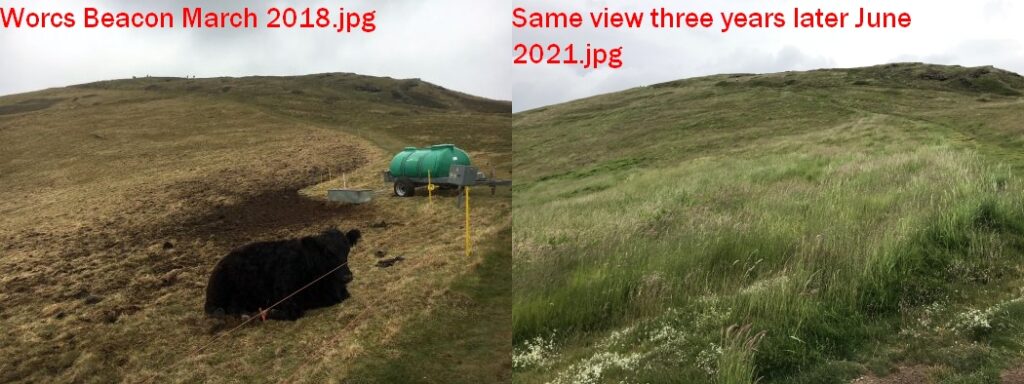Update June 2021. The high hills are suffering from increasing invasion of coarse Yorkshire Fog grass and bracken smothering the fine wavy hair grass. Yorkshire fog is very damaging to insects, plants, mammals not just skylarks and meadow pipits that avoid it. It is unpalatable to stock and they eat other grass first. Seeds can be introduced by cattle dung especially in areas they have trodden bare (poached). The spots near the cattle watering stations were among the first to get invaded and there was very little Yorkshire Fog around before the cows were bought back in 2010 after 10 years absence. The double photo below shows how this happened and the problem is getting worse as the Yorkshire fog benefits from the fertilising effect of cattle dung and nutrients fixed by bracken and gorse as well as further poaching. More information is here.

There were almost certainly no breeding skylarks on the high hills in 2021. However after 6 years without breeding on the high hills it is exciting that two skylarks have turned up very late in the season in late May and were singing once again on the high hills throughout June. There was also a skylark on the Worcester Beacon singing at the very beginning of the breeding season in March but it stayed only a week or so. Both these events indicate that the area is attractive despite the press of visitor numbers. It looks like the skylarks displaced from surrounding farming fields were looking for suitable territory. Many skylarks on surrounding farmland set up territories in March but then abandon them too early in the season because winter sown crops grow too dense for them to forage or hay is cut too early. They were fighting over a small patch of taller grass near the top of the Worcestershire Beacon despite the bank holiday post-lockdown crowds. The same competitions for scarce territory with the right grass are seen on Castlemorton and Poolbrook Commons.
There are now only an estimate of 5-6 territories on the surrounding commons – 2-3 on Hollybed Common, only 1 on the main Castlemorton Common and 2 on Poolbrook Common. Castlemorton in particular looks vulnerable as grazing there has intensified leaving just one patch of longer grass taken up as a territory.
